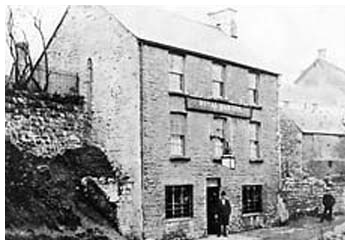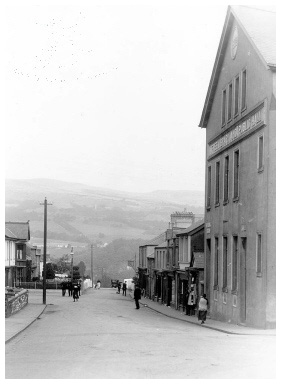
| Trecynon | |
The community of Trecynon began to emerge in the early years of the Nineteenth century. Then known as Heol-y-Felin (Mill Street) because it was established along the road to Llwydcoed Mill, the catalyst for the growth of the settlement was the opening of the Aberdare Ironworks at Llwydcoed in 1800. Trecynon was officially adopted during the Mid Nineteenth Century after it was the winning entry in an eisteddfod competition to name the village. Prior to 1800 there had been only one house at Heol-y-Felin, alongside Hen-Dy-Cwrdd Chapel which had been built in 1751. |
|
| As more people migrated to the Aberdare District looking for work in the Iron Industry there was an increased demand for housing, and Heol-y-Felin continued to expand. Many of the earliest houses in Trecynon were built along the road from Aberdare to Hirwaun, the route of which traveled past the Mount Pleasant Inn, past Carmel Chapel and up Hirwaun Road to the White Lion, where a tollgate had been erected. By the 1850's Heol-y-Felin had become one of the main population centres of Aberdare Parish. Much of Harriet Street had been built between 1830 -1860, Ebenezer Street during the 1840's and during the 1850's the houses of Alma Street, Mount Pleasant Street and Margaret Street amongst others were constructed. |
|
| In 1853 Thomas Webster Rammell was sent by the general Board of Health to conduct an inspection of public health in Aberdare. His report states that whilst drainage conditions in Heol-y-Felin were better than other districts, there were areas of concern:
Rev. John Griffith, Vicar of Aberdare, reported that; "There is not, to my knowledge, a place in Aberdare more filthy than the neighbourhood of the Royal Oak in the same quarter of the town. Mill-Street proper is in a very bad state from the ash-heaps of rubbish and filth thrown into and lying on the centre of the road." Rees Hopkin Rhys reported; "Many of the houses in this quarter are of a very inferior description, and these have no privy accommodation whatever. The new houses, here, as a rule, have one privy for two houses." |
The Royal Oak was a public house in Cynon Place that closed in 1908. These reports suggest that although Heol-y-Felin suffered from many of the same public health problems as the rest of Aberdare, at least steps were being taken to improve matters.
|
Mill Street and the Square
|
Despite the closure of the Aberdare Ironworks in 1875, the growth of the coal trade and increasing population led inevitably to the continued development of Trecynon in the later Nineteenth Century and early Twentieth Century. Edward Street was built in the 1870's, Broniestyn Terrace in 1905. St. Fagan's Church was consecrated on 31st July 1854. The church had been built to serve the needs of the growing Anglican congregation in the upper Cynon Valley .In 1848 the Aberdare British Schools (Ysgol-y-Comin) were built on an unenclosed area of Hirwaun Common and in 1896 the Aberdare Boy's County School was built on the Southern edge of Trecynon. In August 1902 a ceremony was held to mark the laying of the foundation stone of the Trecynon Public Hall and Library by Lord Windsor and D A Thomas M.P. Funds for the construction of the Hall came from a variety of sources, including; The Carnegie Fund - £1,000, Bwllfa Colliery - £105; Lord Windsor - £50; D A Thomas - £50; whilst public subscription raised £180. The hall was officially opened on 10th March 1903 when a grand concert was organised. |
| Aberdare Park | |
Prior to its opening in 1869 the movement for a Public Park in Aberdare had been growing for several years. The proposed site of the park was to be an area of Hirwaun Common near Trecynon. In 1865 49 acres of Hirwaun common was granted to the Churchwardens and Overseers of Aberdare Parish by the Inclosure Commissioners, and in 1866 the Aberdare Board of Health were given possession of the land. Aberdare Board of Health had to apply to the Home Secretary for permission to borrow £5,000 to pay for the work, which was to be paid back in 60 half yearly installments of £161 15s 4d. The cost of this would be borne by a special levy in the rates, a levy which the inhabitants of Hirwaun were exempted from. Right: Aberdare Park entrance circa 1920 |
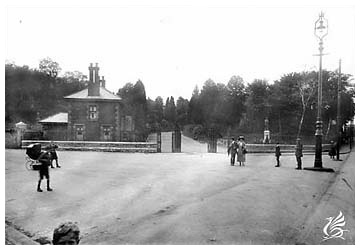 |
| The Park was officially opened on 29th July 1869. A procession formed at the Boot Hotel, Victoria Square before making its way to the park. The procession was led by the Aberdare Volunteer Band; followed by the tradesmen of the town; the Board of Health Members; Richard Fothergill MP and Henry Richard MP; over 1,000 local schoolchildren and bringing up the rear of the procession was the Cyfartha Band. As the procession wound its way through the Park cannons were fired at regular intervals "and the surrounding hills echoed back their thundering reports with grand effect" (Aberdare Times 31st July 1869). Richard Fothergill officially opened the Park and in his speech remarked upon the rapid changes that had occurred in Aberdare in the last 30 years. Transforming it from a small village to a busy industrial town. | |
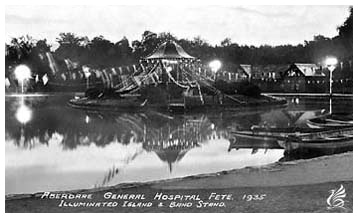 |
Many of the Bye-laws of the park reflect the desire of the Board of Health to create a haven of peace in the burgeoning industrial town. No musical instrument was to be played in the park, no games allowed and no preaching unless the Board of Health gave permission. There was to be no selling or consumption of intoxicating liquor on the park premises. Among the more surprising Bye-laws was the caveat that no person shall beat carpets in the Park and that the servants of the Local Board of health had the power to exclude from the Park any person who is "not clean in his or her person and dressed in clean and decent apparel". Left: Aberdare General Hospital Fete 1935 Illuminated Island and Band Stand |
| In response to the bicycle craze of the 1890's the Board of health issued new bye-laws in 1899. Vehicles were not to be driven or ridden in any way that could endanger other users of the Park. Bicycles were to be ridden at no more that eight miles an hour, ridden in single file and not more than 6 feet from the gutter. | |
In 1910 a bandstand was erected on the boating lake island, which was used in the 1930's as a focal point for a series of illuminated fetes in aid of the Aberdare General Hospital. Lord Merthyr presented the people of Aberdare with the fountain in the Park in 1911 to commemorate the coronation of King George V. The King and Queen Mary visited Aberdare in June 1912 and each planted a tree during their visit to the Public Park. Right: Chris Palmer from the I.O.M at Aberdare Park 17th July 2004 Picture courtesy of John White Photography |
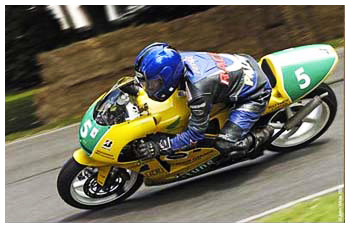 |
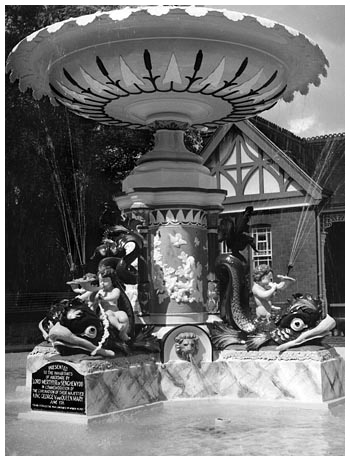 |
Aberdare Public Park remains as popular today as it was when first opened. The uses made of the Park inevitably changed during the Twentieth Century and the amenities offered have changed according to the demands of the Aberdare populace. |
In Aberdare Lord Merthyr presented them with an address from the people of Aberdare in a ceremony at Aberdare Park. Over 8,000 children were in attendance at the Park in order to greet the Royal couple. The most famous element of the visit to Aberdare was their excursion to see a miner's cottage. The cottage chosen was at 71 Bute Street, Aberdare and this property is still known as Queen Mary's Cottage. Following the Royal visit the residents of the house, Mr and Mrs Jones, were visited by hundreds of people from across South Wales who were anxious to see the cup from which Queen Mary had drunk. The Aberdare Leader of 6th July 1912 reported that grateful visitors had filled the cup that the King had drunk from with coppers for the Jones' baby. |
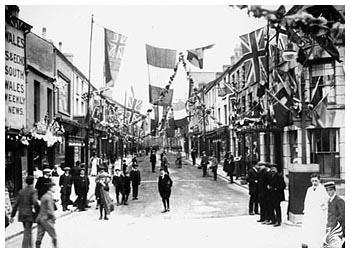 |
| William Williams - Y Carw Coch 1808 to 1872 | |
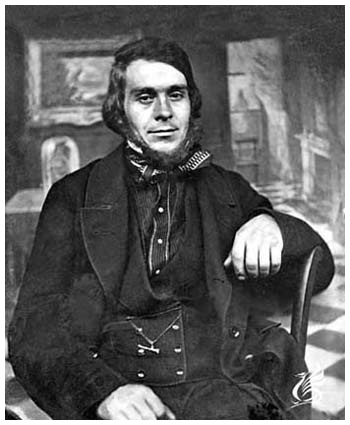 |
As mentioned above, Hen Dy Cwrdd Unitarian Chapel had a strong connection to the reform movement of the early Nineteenth Century. The ministers Rev. Thomas Evans (Tomos Glyn Cothi) and Rev John Jones held radical views, but so also did a number of the congregation. One such member of the congregation was William Williams, more usually known by his bardic name Y Carw Coch (The Red Stag). Left: William Williams (Y Carw Coch) |
| Hen-Dy-Cwrdd Unitarian Chapel | |
When the original Hen-Dy-Cwrdd Unitarian Chapel was erected in 1751 it was the only non-conformist place of worship in the Parish of Aberdare. No other place of worship was founded in the Parish until 1811, when the Baptists founded Carmel Chapel. Although little is known of the early history of Hen-Dy-Cwrdd, it appears that the chapel was founded by the Aberdare section of the Cefn Coed Congregation following doctrinal differences. Right: Hen-Dy-Cwrdd Unitarian Chapel
|
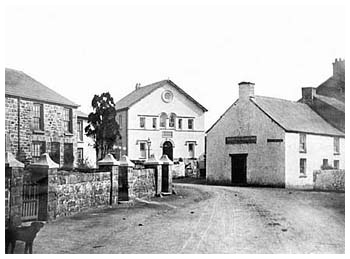 |
| Thomas Evans (Tomos Glyn Cothi) minister from 1811 - 1833 was a political radical who was a pioneer in the reform movement. His replacement John Jones, minister from 1833 - 1863 was also a radical and was one of the founders of the magazine Yr Ymofynnydd. A publication he used to publish his radical ideals. In 1862 a new chapel was built. The cost of the new chapel was £753 15s 4 ½d. John Jones refused to hold a special service of consecration, as he considered such a service was too suggestive of 'popery'. Although the building still survives it closed in the mid 1990's due to a declining congregation. It is hoped that an alternative use will be found for the chapel building in the future. |
|

